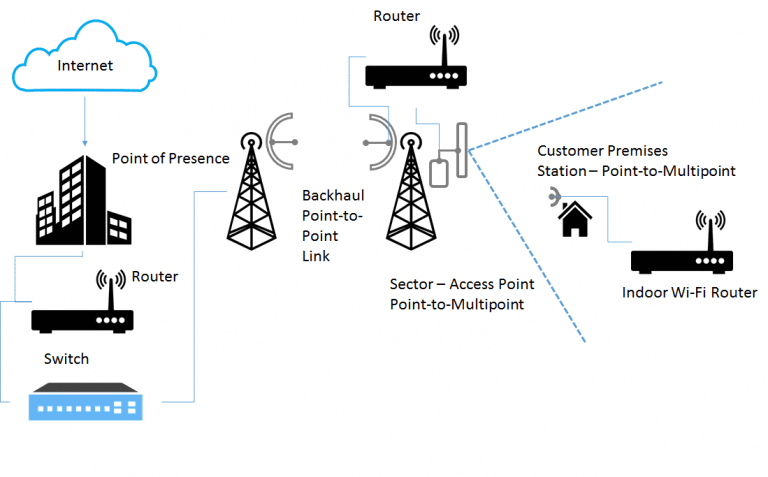What is Point of Presence? Concept, How it Works and Role

Have you ever wondered how data moves between giant networks? PoP is an important link in that chain. TipsMake will help you understand more about what PoP is? And why it is necessary to ensure the speed and stability of the internet connection.
What is Point of Presence?
Point of Presence abbreviated as PoP, is a term used in telecommunications and internet services. It refers to a physical location or access point that connects users to the internet. PoP can take many different forms such as data centers, carrier hotels, or other network connection points.
PoP plays an important role in transmitting data over the network, it is also an important bridge between local users and the wider internet, facilitating access to the huge resources available on the internet.
How does Point of Presence work?
Point of Presence works by establishing a connection between the user and the internet. This connection can be facilitated through various means such as fiber optic infrastructure, satellite.
When a user initiates a request to load a web page, data begins its journey from the user's device to the nearest Point of Presence. Here, the data is processed and then sent to the wider internet. Throughout these processes, the Point of Presence acts as an indispensable intermediary, ensuring an efficient and seamless data flow.
Why is Point of Presence important and necessary?
PoP is the bridge between users and the internet, it plays an extremely important role because:
- Improved speed and reduced latency: Point of Presence reduces the distance data needs to travel, resulting in faster connections and less interruptions. Without PoP, users will experience slow and unstable connections.
- Enhanced user experience: Faster, smoother connections will enhance user experience.
- Reduced costs: By shortening the data route, PoP helps companies save on costs associated with data transmission.

What is Point of Presence?
The Role of PoP in IoT
It can be said that the main function of PoP in the IoT context is to act as a bridge, transferring data between IoT devices and the larger network. The performance and coverage of PoP directly affects the operability of the entire IoT system.
In mobile IoT applications, PoPs must handle a huge number of connections, each with low bandwidth requirements but requiring extremely low reliability and latency. This poses challenges in the processing and optimization of PoP infrastructure. PoP systems are designed to efficiently handle the large number of small data packets that are typical of IoT device communications.
Additionally, security is a core element in IoT systems. PoPs that support mobile IoT are often equipped with advanced security solutions to ensure the integrity and confidentiality of transmitted data. This is especially important because IoT data often includes sensitive information that needs to be protected from cybersecurity threats.
Difference between physical PoP and virtual PoP
Physical PoPs and virtual PoPs serve similar purposes in network infrastructure but differ fundamentally in setup and operation.
- A physical PoP is a physical location that houses networking hardware such as routers, switches, and servers. These facilities are critical in managing and directing internet traffic, providing direct physical connectivity to many different networks.
- Virtual PoPs do not rely on physical infrastructure in a specific location but instead use virtual network functions hosted in the cloud. This virtual approach provides greater flexibility and scalability, allowing for rapid deployment and reconfiguration as network needs change.
While physical PoPs are limited by geographical location, virtual PoPs can provide global network and service access without having to be physically close.
Real World Example of Point of Presence
Internet Exchange Point (IXP)
Telecom operators often set up PoPs at major internet exchange points (IXPs). These PoPs play an important role in efficient data exchange and routing, improving the overall performance of the internet.
PoP Cloud Service Provider
Cloud service providers maintain PoPs in various global locations. These PoPs are essential to ensure low latency access to cloud services.
Edge Locations
Edge storage PoP locations play a vital role in reducing latency by processing data closer to the end user. These PoPs are an indispensable part of scenarios that require real-time data processing.
Internet Service Provider (ISP)
Internet Service Providers (ISPs) set up PoPs to manage and route internet traffic for their subscribers.
Conclude
Point of Presence (PoP) plays a key role in ensuring the stable and efficient operation of the global internet. Understanding the concept, operation and importance of PoP helps you grasp the network infrastructure and how data is transmitted. Hopefully, this article has provided you with the necessary information about PoP and helped you better understand this complex but interesting world of connectivity.
You should read it
- What is an Access Point? Should I use an Access Point, Router or Modem?
- Difference between Access Point and Router
- How to create Restore Point on Windows 10 with just 1 double click
- What is PPTP (Point-to-Point Tunneling Protocol)?
- How to Choose Point of View in Storytelling
- Instructions for creating backup and restore points (Restore Point) on Windows 10
 What is Round Robin? Concept, Features and Benefits
What is Round Robin? Concept, Features and Benefits What is Continuous Data? Difference from Discrete Data
What is Continuous Data? Difference from Discrete Data What is Leased Line? How it works and what are the benefits?
What is Leased Line? How it works and what are the benefits? What is MVVM? Difference between MVVM vs MVC and MVP
What is MVVM? Difference between MVVM vs MVC and MVP What is VDC (Virtual Data Center)? Why is it necessary and important?
What is VDC (Virtual Data Center)? Why is it necessary and important? What is Flush DNS? How to Clear DNS Cache on Windows, Linux, MacOS
What is Flush DNS? How to Clear DNS Cache on Windows, Linux, MacOS